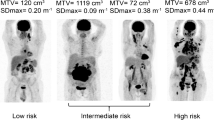Abstract
About 1,700 children in the United States are diagnosed yearly with lymphomas; Hodgkin’s disease accounts for approximately half of these cases, or 6% of all childhood cancers. Contemporary therapy allows for the achievement of remission in the majority of cases. The fusion of positron emission tomography (PET) with CT provides the most accurate imaging method for disease characterization and treatment response. However, experience with 18F-FDG PET-CT is limited in pediatric Hodgkin’s disease. Numerous non-oncologic processes can mimic recurrent or residual tumor. This pictorial addresses mimickers of disease such as uptake in normal structures, infections, transforming germinal canters and effects of therapy on normal tissues. It is essential for radiologists to be familiar with these findings in order to stage disease activity and therapeutic response accurately.












Similar content being viewed by others
References
Hudson MM, Krasin MJ, Kaste SC (2004) PET imaging in pediatric Hodgkin’s lymphoma. Pediatr Radiol 34:190–198
Weiner M, Leventhal B, Cantor A, et al (1991) Gallium-67 scans as an adjunct to computed tomography scans for the assessment of a residual mediastinal mass in pediatric patients with Hodgkin’s disease. A pediatric oncology group study. Cancer 68:2478–2480
Kostakoglu L, Agress H, Goldsmith SJ (2003) Clinical role of FDG PET in evaluation of cancer patients. Radiographics 23:315–340
Hudson MM (2002) Pediatric Hodgkin’s therapy: time for a paradigm shift. J Clin Oncol 20:3755–3757
Krasin MJ, Hudson MM, Kaste SC (2004) Positron emission tomography in pediatric radiation oncology: integration in the treatment planning process. Pediatr Radiol 34:214–221
Barrington SF, O‘Doherty MJ (2003) Limitations of PET for imaging lymphoma. Eur J Nucl Med Mol Imaging 30(Suppl 1):S117–S127
Wahl RL (2002) Principles and practice of positron emission tomography. Lippincott Williams and Wilkins, pp 111–136
Lerman H, Metser U, Grisaru D, et al (2004) Normal and abnormal 18F-FDG endometrial and ovarian uptake in pre- and post-menopausal patients: assessment by PET/CT. J Nucl Med 45:266–271
Frush DP (2001) Imaging evaluation of the thymus and thymic disorders in children. In: Strife JL, Lucaya J (eds) Pediatric chest imaging: chest imaging in infants and children. Springer, Berlin Heidelberg New York, pp 187–208
Fletcher BD, Kauffman WM, Kaste SC, et al (1995) Use of thallium-201 to detect untreated pediatric Hodgkin’s disease. Radiology 196:851–855
Fletcher BD, Xiong X, Kauffman WM, et al (1998) Hodgkin’s disease: use of Tl-201 to monitor mediastinal involvement after treatment. Radiology 209:471–475
Kaste SC (2001) Lymphoma: controversies in imaging the chest. In: Strife JL, Lucaya J (eds) Pediatric chest imaging: chest imaging in infants and children. Springer, Berlin Heidelberg New York, pp 209–223
Barrington S, Maisey M (1996) Skeletal muscle uptake of fluorine-18-FDG: effect of oral diazepam. J Nucl Med 37:1127–1129
Yeung HW, Grewal RK, Gonen M, et al (2003) Patterns of (18)F-FDG uptake in adipose tissue and muscle: a potential source of false-positives for PET. J Nucl Med 44:1789–1796
Hollingshead LM, Goa XL (1991) Recombinant granulocyte colony-stimulating factor (rG-CSF). A review of its pharmacological properties and prospective role in neutropenic conditions. Drugs 42:300–330
Sugawara Y, Fisher SJ, Zasadny KR, et al (1998) Preclinical and clinical studies of bone marrow uptake of fluorine-1-fluorodeoxyglucose with or without granulocyte colony-stimulating factor during chemotherapy. J Clin Oncol 16:173–180
Kaste SC (2004) Issues specific to implementing PET-CT for pediatric oncology: what we have learned along the way. Pediatr Radiol 34:205–213
Tomas MB, Tronco GG, Karayalcin G, et al (2000) FDG uptake in infectious mononucleosis. Clin Positron Imaging 3:176
Hara T, Kosaka N, Suzuki T, et al (2003) Uptake rates of 18F-fluorodeoxyglucose and 11C-choline in lung cancer and pulmonary tuberculosis: a positron emission tomography study. Chest 124:893–901
Goerres GW, von Schulthess GK, Hany TF (2002) Positron emission tomography and PET CT of the head and neck: FDG uptake in normal anatomy, in benign lesions, and in changes resulting from treatment. AJR 179:1337–1343
Hansmann ML, Fellbaum C, Hui PK, et al (1990) Progressive transformation of germinal centers with and without association to Hodgkin’s disease. Am J Clin Pathol 93:219–226
Acknowledgements
Supported in part by grants P30 CA-21765 and P01 CA-20180 from the National Cancer Institute, a Center of Excellence grant from the State of Tennessee from the National Institutes of Health, and by the American Lebanese Syrian Associated Charities (ALSAC).
Author information
Authors and Affiliations
Corresponding author
Rights and permissions
About this article
Cite this article
Kaste, S.C., Howard, S.C., McCarville, E.B. et al. 18F-FDG-avid sites mimicking active disease in pediatric Hodgkin’s. Pediatr Radiol 35, 141–154 (2005). https://doi.org/10.1007/s00247-004-1340-3
Received:
Revised:
Accepted:
Published:
Issue Date:
DOI: https://doi.org/10.1007/s00247-004-1340-3




